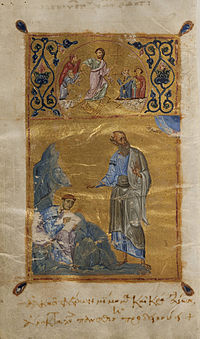Codex Basilensis A. N. IV. 2
| New Testament manuscript | |
 Folio 265 verso, portrait of John and Prochor | |
| Name | Basiliensis A.N.IV.2 |
|---|---|
| Text | New Testament (except Apocalypse) |
| Date | 12th century |
| Script | Greek |
| Now at | Basel University Library |
| Cite | K. Lake, Codex 1 of the Gospels and its Allies, (Cambridge 1902) |
| Size | 18.5 cm by 11.5 cm |
| Type | Caesarean, Byzantine text-type |
| Category | III, V |
| Hand | elegantly written |
| Note | member of f1 |
Codex Basilensis A. N. IV. 2 is a Greek minuscule manuscript of the entire New Testament, apart from the Book of Revelation. Using the study of comparative writings styles (palaeography), it is usually dated to the 12th century CE. It is known as Minuscule 1 (in the Gregory-Aland numbering of New Testament manuscripts), δ 254 (in von Soden's numbering of New Testament manuscripts),[1] and formerly designated by 1eap to distinguish it from minuscule 1rK (which previously used number 1).
The manuscript was prepared for liturgical use with marginalia (text division), and has almost completely survived; Erasmus used it for his Novum Instrumentum omne (an edition of the Greek New Testament). The text of the manuscript has been cited in all critical editions of the Greek New Testament; in this codex, the text of the Gospels is more highly esteemed by scholars than that of the remaining New Testament books. The codex is housed at the Basel University Library, with shelf number A. N. IV, 2 (earlier B. VI. 27).[2]
Description
[edit]The manuscript is a codex (precursor to the modern book) made of 297 parchment leaves (18.5 cm by 11.5 cm), containing the entire New Testament (except of Book of Revelation) in the following order: the Gospels, the Acts of the Apostles, the General epistles, and the Pauline epistles (Hebrews is the last book in Paul). The text is written in one column per page, 38 lines per page.[3] It was originally accompanied by miniatures, which were stolen before 1860–1862 (except one before the Gospel of John, which remains).[4]: 190–191
The dimensions of the text are 13.6 cm by 6.8 cm.[2] It was written on parchment continuously and without separation in elegant minuscule, furnished with breathings (spiritus asper, spiritus lenis), accents, and Iota adscript. The initial letters are gilt, and on the first page of each Gospel the full stop is a large gilt ball.[4]: 190–191
The text is divided according to chapters (known as κεφαλαια / kephalaia) whose numbers are given in the margin, with their titles (known as τιτλοι / titloi) at the top of the pages. The text of the Gospels is divided according to the smaller Ammonian Sections (in Matthew 352, in Mark 236 with last numbered section in 16:12, in Luke 340, in John 227), but references to the Eusebian Canons are absent.[5] The Book of Acts and the epistles have the Euthalian Apparatus.[5]
It contains prolegomena, synaxaria (a list of saints), two types of lectionary markings in the margin (for liturgical reading), and pictures (e.g. a portrait of John the Evangelist and Prochorus). The later type of liturgical notes, so called αναγνωσεις (only for Gospels), were added by a later hand (in red). There are 116 αναγνωσεις in the Gospel of Matthew, 70 in the Gospel of Mark, 114 in the Gospel of Luke, and 67 in the Gospel of John.[5] In the 15th century, the later hand added Prolegomena.[6]: x
The codex contains a scholion questioning the authenticity of Mark 16:9-20.[6]: 92 The Pericope Adulterae (John 7:53-8:11) is placed after John 21:25.[5]
Text
[edit]
In Aland's Profile, biblical scholars Kurt and Barbara Aland placed the codex's Gospels in Category III, meaning it has historical importance, with the profile of 1191, 802, 601/2, 69s.[7] This means the text of the codex agrees with the Byzantine standard text 119 times, with the original text against the Byzantine 80 times, and with both the Byzantine and original text 60 times. There are 69 independent or distinctive readings in the Gospels.[7]: 107 While the Gospels in codex 1 are considered a representative of the Caesarean text-type,[8]: 87 the remainder of the books of the New Testament are considered a representative of the Byzantine text-type and falls into Category V, the lowest and least important in Aland's Profile.[7]
It belongs to the textual Family 1 with manuscripts 118, 131 and 209.[8]: 86–87 Classification in this textual family was supported by the Claremont Profile Method, but it was only examined with this method in Luke 1, Luke 10 and Luke 20.[9]
Griesbach was the first who noted its similarities to the text of Origen's commentary to the Gospel of Matthew.[10] According to Hort, its text preceded the byzantine text-type.
Biblical scholar Kirsopp Lake compared the text of the codex with the text of Stephanus, and showed that minuscule 1 contains 2243 variants from the Textus Receptus in the sections comprising Matthew 1–10, Matthew 22–Mark 14, Luke 4-23, and John 1-13 and 18.[6]: XXIV
In Matthew 27:16, it has the well-known textual variant "Ιησουν τον Βαραββαν" (Jesus Barabbas). This variant also appears in Codex Koridethi (Θ), Minuscule 700, and other members of the group ƒ1.[11]
History
[edit]

Textual critics and palaeographers like Wettstein, Tischendorf, Scrivener and Gregory dated the manuscript to the 10th century.[12] Henri Omont and Lake dated it to the 12th century, and Dean Burgon to the 12th or 13th century. It is dated by the Institute for New Testament Textual Research to the 12th century[7][13] because the frequent occurrence of enlarged letters, rounded breathing marks, flourishes and ligatures seem to eliminate earlier dates.[2]
The manuscript was presented to the monastery of the Preaching Friars by Cardinal Ragusio, general of the Dominicans.[5] It was used by Desiderius Erasmus in the first edition of his Novum Testamentum (1516); as a result, some of its readings are found in the Textus Receptus. Erasmus used this codex very little because its text was different from other manuscripts with which he was acquainted. Oecolampadius and Gerbelius (Erasmus's sub-editors) insisted that he use more readings from this codex in his third edition; however according to Erasmus, the text of this codex was altered from the Latin manuscripts and had secondary value.[14] Since 1559, it has been kept at the University of Basel,[5] along with Codex Basilensis and minuscule 2.
Johann Albrecht Bengel used several extracts from the codex, and Wettstein was the first who thoroughly examined it. According to him, in the Gospels its text agrees with the most ancient codices and patristic quotations; therefore, he called it number one.[15] In 1751 he changed his high opinion (Novum Testamentum Græcum),[16] dating the codex to the 10th century. Wettstein collated this manuscript twice, with many errors; according to biblical scholar Samuel Prideaux Tregelles, his collation was incorrect in more than 1,200 readings. Leonard Hug supported Wettstein's last opinion that the codex was Latinisated.[17] Tregelles and Roth again collated the text of this codex, and Tregelles noticed that it was textually close to Minuscule 118. Dean Burgon noticed that minuscules 131 and 209 were also textually similar. This entire group was examined by Kirsopp Lake in 1902, and it was called "the Lake Group" (or Family 1). The text of the family was established on the basis of minuscule 1 (the manuscript was collated with Minuscules 118, 131, and 209).[6]
Scrivener demonstrated that at least 22 verses of Erasmian's Greek New Testament text were derived from minuscule 1:
- Matthew 22:28; Matthew 23:25; Matthew 27:52; Matthew 28:3, Matthew 28:4, Matthew 28:19, Matthew 28:20
- Mark 7:18, Mark 7:19, Mark 7:26; Mark 10:1; Mark 12:22; Mark 15:46
- Luke 1:16, Luke 1:61; Luke 2:43; Luke 9:1, Luke 9:15; Luke 11:49
- John 1:28; John 10:8; John 13:20[4]: 183–184
The manuscript has been cited in all critical editions of the Greek New Testament, and systematically cited in the third and fourth editions edited by United Bible Societies (UBS3[18] and UBS4[19]) and Nestle-Aland's 26th and 27th editions (NA26[11]: 13 and NA27). In NA27, the codex is cited as a witness of the first order.[20]
See also
[edit]References
[edit]- ^ Gregory, Caspar René (1908). Die griechischen Handschriften des Neuen Testament. Leipzig: J. C. Hinrichs. p. 48.
- ^ a b c Anderson, Amy S. (2004). The Textual tradition of the Gospels: Family 1 in Matthew. Leiden; Boston: Brill. p. 108.
- ^ Aland, Kurt; M. Welte; B. Köster; K. Junack (1994). Kurzgefasste Liste der griechischen Handschriften des Neues Testaments (2 ed.). Berlin; New York: Walter de Gruyter. p. 47. ISBN 3-11-011986-2.
- ^ a b c Scrivener, Frederick Henry Ambrose; Edward Miller (1894). A Plain Introduction to the Criticism of the New Testament. Vol. 1 (4th ed.). London: George Bell & Sons.
- ^ a b c d e f Gregory, Caspar René (1900). Textkritik des Neuen Testaments. Vol. 1. Leipzig: J.C. Hinrichs. p. 127.
- ^ a b c d Lake, Kirsopp (1902). Codex 1 of the Gospels and its Allies. Texts and Studies, volume VII. Cambridge.
{{cite book}}: CS1 maint: location missing publisher (link) - ^ a b c d Aland, Kurt; Aland, Barbara (1995). The Text of the New Testament: An Introduction to the Critical Editions and to the Theory and Practice of Modern Textual Criticism. Erroll F. Rhodes (trans.). Grand Rapids: William B. Eerdmans Publishing Company. p. 129. ISBN 978-0-8028-4098-1.
- ^ a b Metzger, Bruce M.; Ehrman, Bart D. (2005). The Text of the New Testament: Its Transmission, Corruption and Restoration. New York; Oxford: Oxford University Press. ISBN 978-0-19-516122-9.
- ^ Wisse, Frederik (1982). The Profile Method for the Classification and Evaluation of Manuscript Evidence, as Applied to the Continuous Greek Text of the Gospel of Luke. Grand Rapids: William B. Eerdmans Publishing Company. p. 53. ISBN 0-8028-1918-4.
- ^ Griesbach, Johann Jakob (1793) [1785]. Symbolae criticae ad supplendas et corrigendas variarum N. T. lectionum collectiones. Vol. 1. Halle. pp. CCII–CCXXIII.
- ^ a b Aland, Kurt; Black, Matthew; Martini, Carlo M.; Metzger, Bruce M.; Wikgren, Allen, eds. (1981). Nestle-Aland Novum Testamentum Graece (26 ed.). Stuttgart: Deutsche Bibelstiftung. ISBN 3-438-051001. [NA26]
- ^ Tischendorf, Constantin von (1859). Novum Testamentum Graece (7 ed.). Lipsiae. p. CXCIV.
{{cite book}}: CS1 maint: location missing publisher (link) - ^ "Liste Handschriften". Münster: Institute for New Testament Textual Research. Retrieved 31 December 2012.
- ^ Tregelles, Samuel Prideaux (1856). An Introduction to the Critical study and Knowledge of the Holy Scriptures. London. p. 208.
{{cite book}}: CS1 maint: location missing publisher (link) - ^ Wettstein, Johann Jakob (1730). Prolegomena ad Novi Testamenti Graeci. p. 57.
- ^ Wettstein, Johann Jakob (1751). Novum Testamentum Graecum editionis receptae cum lectionibus variantibus codicum manuscripts. Amsterdam: Ex Officina Dommeriana. pp. 42–44.
- ^ Hug, John Leonard (1827). Writings of the New Testament. Daniel Guildford Wait (trans.). London. p. 165.
- ^ Aland, Kurt; Black, Matthew; Martini, Carlo M.; Metzger, Bruce M.; Wikgren, Allen, eds. (1983). The Greek New Testament (3rd ed.). Stuttgart: United Bible Societies. p. XIX.
- ^ Aland, Kurt; Aland, Barbara; Martini, Carlo M.; Metzger, Bruce M.; Karavidopoulos, J., eds. (1983). The Greek New Testament (4th ed.). Stuttgart: United Bible Societies. p. 17. ISBN 978-3-438-05110-3.
- ^ Aland, Kurt; Aland, Barbara; Martini, Carlo M.; Metzger, Bruce M.; Karavidopoulos, J., eds. (2001). Novum Testamentum Graece (27 ed.). Stuttgart: Deutsche Bibelgesellschaft. pp. 58*.
Further reading
[edit]- Omont, Henri (1886). Catalogue des mss grecs des bibliothèques de Suisse. Leipzig.
{{cite book}}: CS1 maint: location missing publisher (link)
External links
[edit]- Online images of minuscule 1 (Digital Microfilm) at the CSNTM.
- R. Waltz, Minuscule 1, Encyclopedia of Textual Criticism (2007)
- IDS BS BE Archive
- Images NT.VMR


 French
French Deutsch
Deutsch